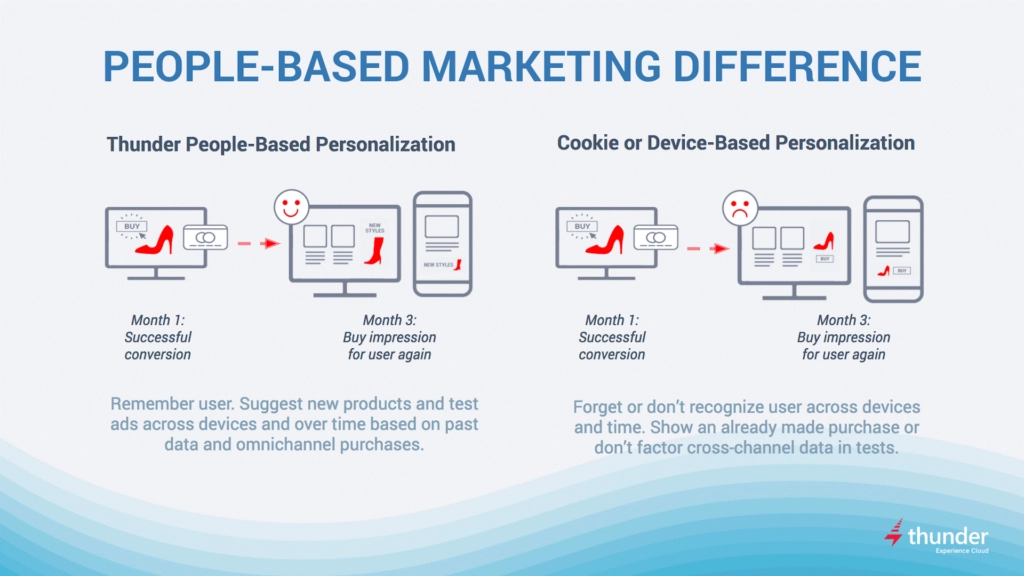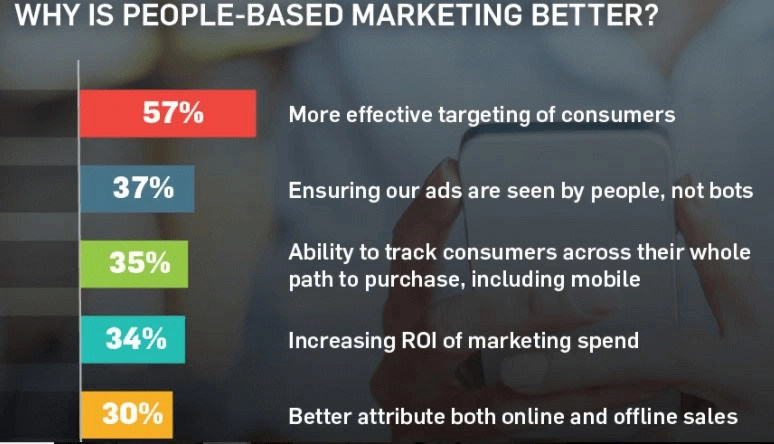
Introduction
Buyers are today engaging more with their preferred brands than they did years ago.
By beginning their search online, they read what other shoppers say on social media, product reviews and even compare coupons before making a purchase.
Considering that 94% of B2B buyers invest in online research before making a purchase decision, each of these touch points is important in helping marketers understand what customers need or want.
To reach their audience, B2B marketers have been using cookies and digital pixels to target prospects and customers.
With these two digital footprints, businesses see what online visitors view on their websites and can therefore send relevant content to them when they visit other sites.
While cookies and pixels work well in boosting brand awareness for B2B companies, they have a major limitation – they focus more on devices and not people.
A study by Variety shows that on average, a household in the US has 11 devices connected to the internet. But, even with this high number of devices, your marketing efforts may not bear much fruit if the focus remains on pixels and cookies.
People-based marketing comes in handy to fill this gap. With this marketing strategy, B2B companies can take their customer relationship management (CRM) data and use it to identify online targets.
In this article, we explore how B2B companies can tap the people-based marketing (PBM) strategy to drive sales revenue. But, before we do that, let’s define PBM and what it means for B2B marketing.
What is People-Based Marketing?
The concept of people-based marketing was introduced in 2014.
By definition, people-based marketing involves identifying prospects or customers as individuals and not cookies or devices.
In most simple terms, people-based marketing involves collecting customer data from online and offline sources and using the rich customer profile to correctly recognize and target customers across different devices.
Essentially, people-based marketing connects B2B brands with real customers. Rather than looking at customer behavior in silos like search, email, display and social – people-based marketing places individuals at the heart of marketing efforts.
Because of its focus, people-based marketing represents complete departure from targeting the devices that your prospects or customers use, to connecting with them with the right message and at the right time.

Source: Thunder
Since its introduction, it has gained popularity in the marketing world. Statistics show that marketers who implement this strategy experience up to 83% more success in their marketing campaigns.
This is because PBM gives marketers the confidence that their marketing message reaches their best customers and drives measurable results.
So, What Does PBM Mean for B2B Marketers?
PBM capitalizes on technology to market B2B products or services across different communication channels. The success of the PBM strategy depends on how well marketers understand their target audience.
This is important considering that consumer behavior is constantly changing as new technologies emerge. A report by the Consumer Technology Association shows that 50% of people in the US are often on a second screen as they watch television.
To attract such people, B2B marketers should embrace multichannel marketing to interact with potential customers on different communication channels.
Here is a good example of a multichannel shopper:
When shopping online, a B2B customer comes across a customer service software when researching the product on his laptop. He puts the purchase on hold. The following week, he buys the software through his phone.
He is a multichannel shopper. About two thirds of B2B shoppers are like him. They use two or more channels to shop online. This understanding is important for B2B marketers who use the PBM strategy.
Using appropriate customer data, they can send targeted ads to different platforms and devices based on the priorities and behaviour exhibited by their target audience and generate positive results as shown in the image below.

Source: RBR
How to Drive a Successful PBM Marketing in B2B?
There are several factors that determine how successful PBM will be in B2B marketing. These are:
A. Customer or Prospect Identification
To succeed with PBM, B2B marketers must identify and connect correctly with their target audience across different devices.
Typically, a customer navigates various devices – tablets, smartphone, PC computer – in a day. This means they only spend a short time online on each device. Connecting with customers across devices helps in ensuring cross-device recognition.
Failure to track journey well can result in inaccurate assumption of customer behavior. This means you work with incorrect data to design marketing campaigns.
Because the customer data is inaccurate, the marketing campaigns will not yield the desired results. To avoid all this, B2B markets should identify customers on different devices and channels.
B. Customer Data
In today’s business environment, companies have customer data that ranges from email engagement to device information and purchase data.
To succeed in PBM, B2B marketers should embrace the identification-first approach to customer data. This means going beyond capturing historical data to getting real-time data on customer behavior including:
- Tech devices that customers use
- Interactions that customers have with their sites
- Product categories that customers browse
- Shopping carts that customers fill
Capturing this data gives B2B marketers an advantage when it comes to targeting customers. They can link all these data points to get a proper view of their customers.
C. Data Automation
B2B companies can succeed with PBM if they automate customer data. Automation helps companies in getting a clear picture of customer behavior while anchoring customer data to one source. This enables brands to power their omnichannel marketing efforts and create a cohesive marketing strategy.
Tips for Driving PBM Strategy in B2B Marketing
B2B markers can drive PBM marketing by:
1. Targeting a Finite Audience
Many people watch TV, use social media, search the web using Google and browse the internet on a daily basis. However, no single channel is more important than the other for marketers. To drive their PBM strategy, B2B marketers should narrow their target and focus on a finite audience.
To identify such an audience, marketers should stop using standard advertising methods of targeting. Instead, they should make better use of first party data and create a good foundation for creating the right target audience.
Almost every channel that customers use will have first-party data – B2B marketers can extract data from those channels and use it to identify the correct audience.
2. Shifting Offline Data to the Online Environment
B2B companies have numerous offline data about their customers such as email addresses, mailing address and phone numbers. However, few marketers use data onboarding to shift this data to the online environment.
Identifying your company’s offline customers online enables it to segment your target audience. After doing this, you can:
- Identify customers who are at risk of quitting your brand
- Take proactive actions to keep them from disengaging with your company
- Create upselling and cross-selling opportunities for them
You can shift your offline data online using tech solutions like Oracle Data Cloud that link offline records to their online details by matching their identification data. Once online, B2B marketers can proceed to increase their use of matching information to connect offline records with online users.
3. Focusing on the Best Prospects
Before you roll out your PBM strategy, you need to determine what your new customers should be like.
In an ideal situation, they should be just like your existing customers. This will apply mostly to offline prospects that you integrate in advertising platforms like social media and Google.
To prospect on the best customers, B2B marketers should find ways of enhancing first party data that they already have. In most instances, this kind of data is limited in some aspects.
These limitations make it challenging for marketers to build high value lookalikes for onboarded offline prospects. By boosting first party data, B2B marketers are able to create new customer models through the use of offline and third-party consumer data.
4. Understanding Prospect’s Purchase Journey
After identifying the right audience, B2B marketers should focus on understanding the purchase journey of their audience.
The best way to do this is to be present in the conversations your audience has throughout the purchase journey. This will enable you to generate interest, create awareness about the solutions you offer, and encourage action.
You can start the process by mapping your audience using historical data and intuition. However, focus on learning and using analytics attribution to get detailed information that will lead you to the conversations that your audience could be having.
A tool like Google Analytics does this well, and even allows you to view how media like social, search and display interact and even work together.
Analytic tools also provide insights on the number of interactions or touch points that happened before customers started conversing.
With these insights, B2B marketers get to know how different types of media interact in order to create a media portfolio mix. They also get clues on whether there is a need to create an internal attribution model.
UnboundB2B’s Approach to People-Based Marketing
At UnboundB2B, we support B2B companies to undertake people-based marketing and account-based marketing.
Our account-based marketing approach helps B2B companies to use first-party data to identify key accounts. We have a huge database of more than 60 million professions and 150 million companies that we use to achieve this.
Once this is done, we apply the people-based marketing approach to take this further. We support B2B companies to leverage first-party and third-party customer data to target those accounts with the right messages across different devices and channels.
Final Thoughts
People-based marketing has gained popularity in recent years with at least 93% B2B marketers investing in it.
The shift from cookies and pixels to individuals enables B2B marketers to effectively use online and offline customer data to target consumers with the right message at the right time on different devices.
If your company still uses cookies to retarget consumers, you are likely to experience a huge improvement if you start targeting consumers across devices.
Most companies use first party data to integrate PBM in their marketing strategy. If your company already has a database of this type of data, you can easily start implementing PBM. You can then boost this strategy later by integrating third party data and following the four steps discussed above.
Our blog
Latest blog posts
Tool and strategies modern teams need to help their companies grow.

It is for fact that today's buying environment demands more. With longer sales cycles...

To build a marketing strategy that drives real results, you need more than creative i...

The 95/5 rule in B2B marketing shows that while only 5% of buyers are ready to purcha...







